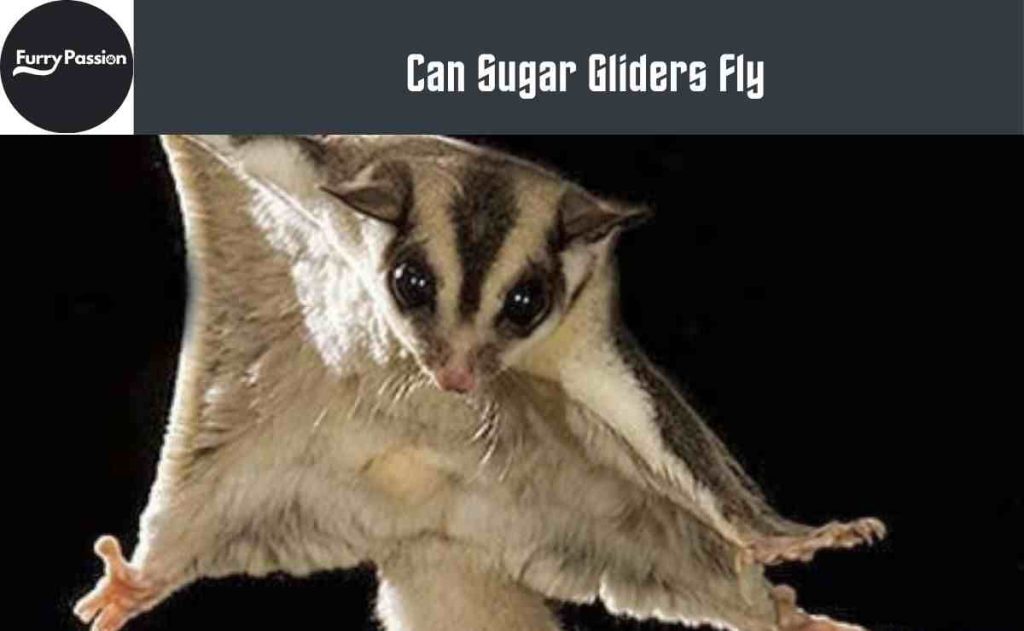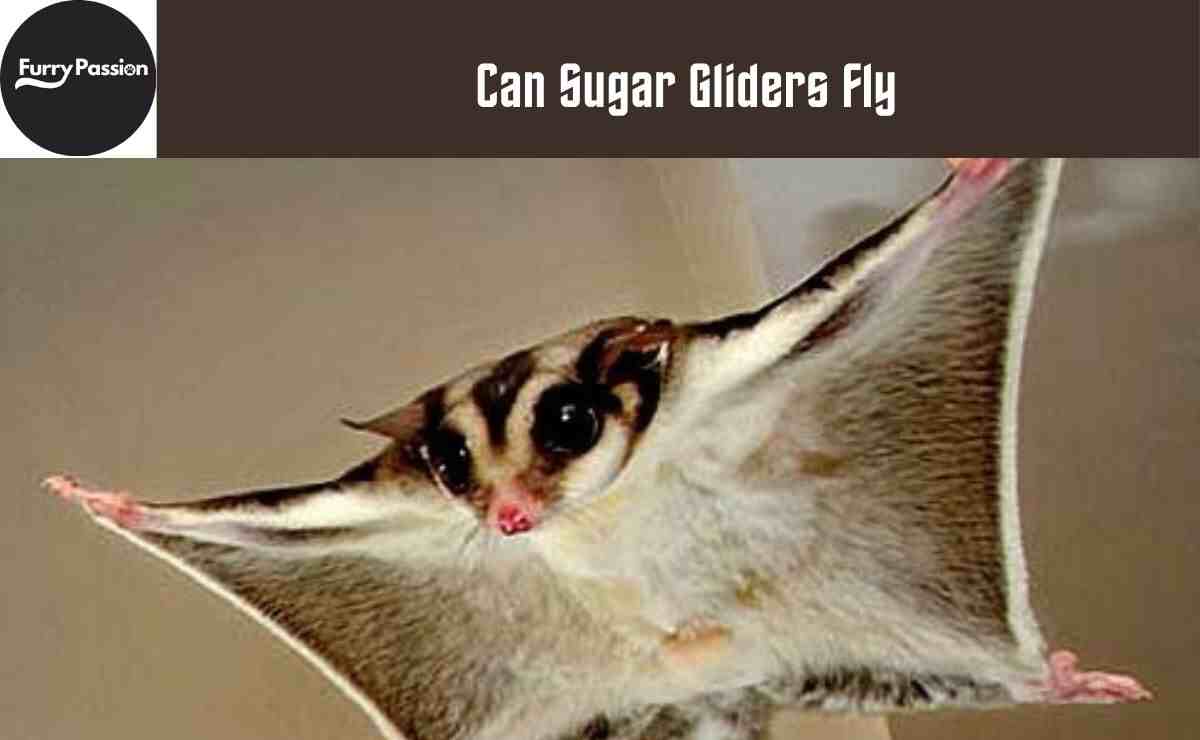Only three mammals can fly through the air – flying squirrels, flying lemurs, and sugar gliders. Though there are some similarities between them, none of them are related. So can sugar gliders actually fly?
In reality, sugar gliders don’t fly. Their physical characteristics are not supportive enough to fly through the air. But it is a matter of surprise how they can manage to fly up in the air. To know all the secrets, go through the whole post.
Can Sugar Gliders Fly?

Sugar gliders, scientifically known as Petaurus breviceps, are small marsupials native to Australia and New Guinea. They are the members of the same family as kangaroos and koalas.
First of all, sugar gliders don’t actually fly but they glide. They are not capable of true flight like birds and bats.
Sugar gliders have a specialized soft membrane of skin called a patagium. This membrane stretches from their wrists to their ankles and acts like a parachute.
Sugar gliders rarely come to the ground. They usually glide from trees to trees to find food and shelter. So this patagium allows them to survive and escape from predators.
The gliding movement of sugar gliders is more related to the paper plane but in a cuter version. But they are capable of steering themselves in mid-flight. They can control their direction and trajectory. Moving their limbs and adjusting the tension of the membrane, they can simply turn left and right.
How Long Sugar Gliders Fly?
Sugar gliders primarily glide to travel between trees in their natural habitat and they can cover impressive distances. On average, sugar gliders are capable of gliding up to 150 feet in a single glide. However, with favorable wind conditions, they can glide even farther distances.
They have an impressive gliding range, capable of floating through the air for a distance nearly similar to the width of a football field.
Despite their small size and limited flight capabilities, sugar gliders are agile and efficient gliders in their natural habitat. The distance a sugar glider can glide depends on factors such as their age, weight, physical condition, and the environmental conditions at the time of the glide. In captivity, sugar gliders may glide shorter distances due to limited space.
How Much Space Do Sugar Gliders Need In Home?
When it comes to giving sugar gliders space to glide around, think about the forests they’re from. They climb from tree to tree in their habitat.
Now, you might worry about finding a big enough cage for them. But you shouldn’t. A 36 inches tall, 24 inches deep, and 24 inches wide cage should be okay for them. Just make sure it’s not empty. These little guys love to move, so toss in some toys and obstacles to keep them entertained.
Sugar gliders need their freedom. It’s best to let them out of their cage every day so they don’t feel too cooped up. They’re social critters too, so think about bonding with them. They get pretty sad and lonely if they’re alone for too long.
Sugar gliders are night owls. They’re most active when you’re getting your shut-eye, so having another sugar glider around to keep them company is a good idea. If you’re getting a pair, a male and a female make a great team.
How Do Sugar Gliders Glide?

Sugar gliders glide through their patagium. It is a thin skin that simply works as their wings. The sides of the patagia are connected from fifth forefinger to the back of their ankle. This part mainly supports their flight.
Moreover, the sugar glider’s long furry tail also assists their flight. It helps to move their direction along with their arms when gliding like a steering wheel.
The patagia are in airfoil shape allowing air to flow both above and below the wing. It creates differences in air pressure. When the wind flows over the patagia, the sugar glider accelerates.
As the airspeed increases, the air pressure above the wing decreases, while the pressure beneath remains constant. This pressure difference results in a force under the wing, leading to lift.
Hence, these marsupials typically inhabit dense forests abundant with trees, providing ample opportunities for them to leap and glide. Despite being palm-sized, sugar gliders utilize their patagia to stretch and jump, creating enough airfoil to glide through the air.
Interestingly, designers have drawn inspiration from the flying mechanism of sugar gliders and incorporated it into human technology, notably seen in the development of human flying jumpsuits. These suits employ the concept of utilizing flaps between the hands and feet to generate lift.
This great principle isn’t exclusive to sugar gliders; it’s also utilized in various man-made structures such as airplanes, fans, windmills, and other mechanical devices to facilitate movement.
How to Train Sugar Gliders to Glide Toward You?
Training sugar gliders to glide towards your hand can be a rewarding and fun process, but it requires patience, consistency, and proper techniques. Here are some steps you can follow:
1. Positive reinforcement
Use small treats like mealworms or fruits to reward your sugar glider when it moves toward your hand or glides in your direction. This will help them associate gliding towards your hand with a positive experience.
2. Gradual approach
Start by placing your hand near your sugar glider’s perching area, allowing them to become comfortable with your presence. Slowly move your hand closer over time, encouraging them to glide towards you.
3. Building trust
Spend time bonding with your sugar glider through gentle handling and interaction. This will help them feel more comfortable and secure around you, making them more likely to glide towards your hand.
4. Consistent training sessions
Practice the gliding training regularly to reinforce the behavior and build a strong bond with your sugar glider. Be patient and consistent, as gliding training may take time depending on your sugar glider’s temperament and age.
5. Use a target stick
You can also use a target stick to guide your sugar glider towards your hand. Start by targeting the stick near your hand and gradually move it closer, encouraging them to follow and glide towards you.
How to Bond with Your Sugar Glider?
If you have a sugar glider, you probably worry about them when they’re out of their cage. You want to give them space, but letting them roam free can be risky because they might escape. But don’t worry, if you make a bond with them, they will come back to you.
Sugar gliders are social creatures that thrive on bonding with their human companions. To bond with your sugar glider, start by spending quality time with them every day. This can include playing with them, offering treats, and simply sitting near their cage to get them accustomed to your presence.
Handling your sugar glider gently and regularly will help them become more comfortable with you and develop trust. Creating a safe and enriched environment for your sugar glider is also important for building a bond.
With time, effort, and proper care, you’ll be able to build a strong and lasting relationship with your sugar glider.
Final Thoughts
As their name suggest, sugar gliders can glide, can’t fly. They are gliders that use their patagium to glide through the air with ease.
Sugar gliders are remarkable gliders and they can cover significant distances in the wild using their unique flying ability.
